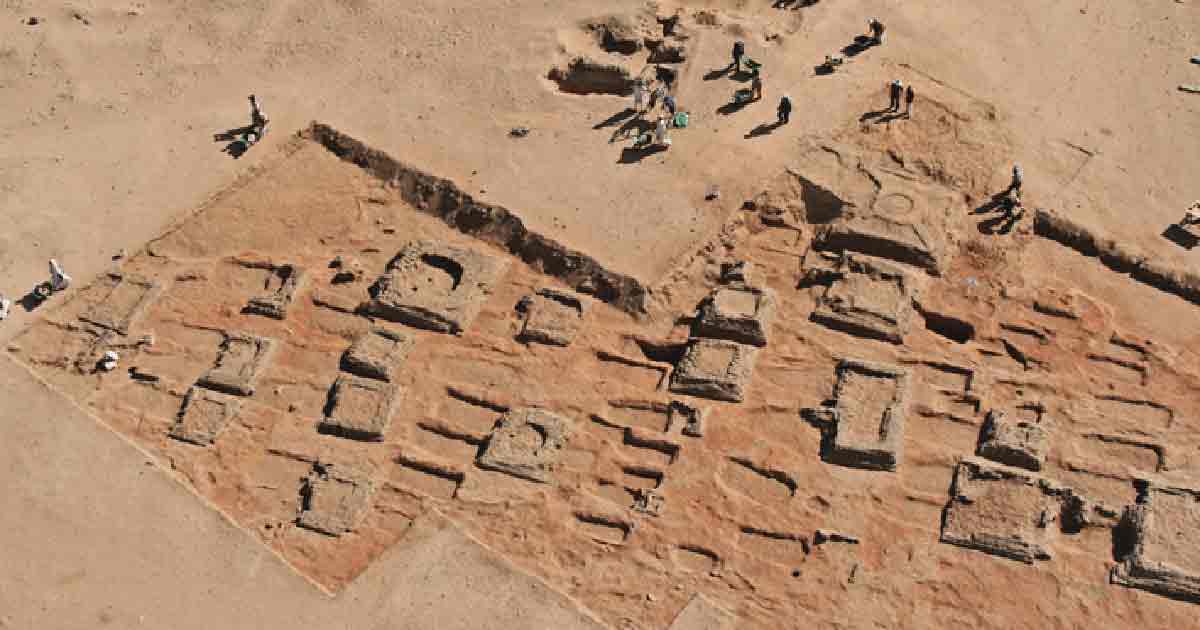The Mystery of the Miniature Pyramids of Sedeinga in Sudan
From Egyptian Pyramids to the Miniature Pyramids of Sudan
The Egyptians built pyramids as tombs for hundreds of years, yet the origins and significance to the Pharaohs of this trend remain shrouded in mystery. Of course, it's widely known that no tomb belonging to Khufu has ever been discovered inside the Great Pyramid of Khufu. Remarkably, the Great Pyramid is devoid of hieroglyphics throughout its expanse, except for a small, inconspicuous spot in a remote section where a rough depiction of the Khufu sign was found. This solitary instance raises doubts about the pyramid's intended function as a tomb.
- Ancient Tomb Reveals Cultural Entanglement between Egypt and Nubia
- 16 Ancient Pyramids, Burial Sites for a Vanished Kingdom, Found in Sudan
Towards the end of the 6th century BC, the construction of pyramids as tombs ceased—a puzzling shift considering their longstanding importance until that time. It was during this era that Nubians (Nubia is now a region of Sudan) invaded and occupied Egypt. They ruled Egypt for about a century before they were expelled. Nevertheless, the enduring influence of Egypt on the Nubian culture likely persisted long after their rule.

Remains of the miniature pyramids at the Necropolis of Sedeinga. (Laurent de Walick / CC BY 2.0)
Dense Field of Miniature Pyramids Near Sedeigna
The pyramids discovered in Meroe in Sudan were medium size pyramids, 80 in number, which were similar but not identical to the Egyptian pyramids. These were used as tombs for their wealthy Nubian royals and other prominent individuals. Until now more than 220 royal pyramids have been discovered in Sudan.
The Nubians followed the Egyptian pyramid shape (smaller in size) with a capstone on the top and reserved exclusively for royals rather than the general populace. The capstones would be symbols of the sun such as solar discs with figures emerging from them. However, it's worth noting that Sudan has yielded more pyramid discoveries in total than Egypt, raising questions about the notion that the Nubians simply 'appropriated' the pyramid tradition from the Egyptians.
The interesting part of the story lies in a cemetery that was recently discovered in Sudan in the area of Sedeigna, 450 miles from Meroe. New archaeological excavations have found a dense field of miniature pyramids packed closely together that range from 30 inches (76.2 cm) up to 32 feet (9.75 m) where the smaller ones were built over the graves of children. Inscriptions that were discovered revealed that the cemetery once held thousands of burial chambers beneath the small pyramids making the cemetery even more intriguing.

Aerial photo of the miniature pyramids at Sedeinga in Sudan. (Vincent Francigny / Sedeinga archaeological mission)
Unraveling Mysteries of the Miniature Pyramids at Sedeinga
Typically, in cemeteries of this nature, one might anticipate encountering approximately 20 to 30 pyramids, each serving as a final resting place for members of the elite. But here things are different, as Vincent Francigny a research associate of the American Museum of Natural History explained.
The era in which the cemetery at Sedeinga was constructed coinciding with the decline of the pyramid's exclusivity to royalty. Nevertheless, sheer number of monuments and their purpose remains unexplained, as noted by Francigny. It could possibly suggest that pyramid-shaped monuments in various sizes were accessible to all, perhaps indicating the existence of equality amongst the populace.
Some of the excavated monuments revealed a peculiar round stone structure inside, the purpose of which remained puzzling as it did not seem to provide any structural support to the pyramid itself. Francigny speculated that this circular feature might have originated from an older burial tradition, which later evolved under the influence of Egyptian culture.
Situated as a crucial nexus between the Nubian kingdom of Meroe and Egypt, Sedeinga served as the primary stop for traders journeying between the two regions. This historical significance likely accounts for the wealth of Sedeinga, reflected in the abundance of monuments discovered at the cemetery.
Pyramid Traditions and Cultural Appropriation Between Nubia and Egypt
If we entertain the notion that the Nubians “appropriated” the pyramid tradition from the Egyptians, it raises intriguing questions about the transmission of cultural practices between civilizations. The fact that even royalty adopted this tradition suggests its perceived significance. However, the eventual abandonment of pyramid construction by the Egyptians implies a shift in cultural priorities, perhaps indicating a change in societal values or technological advancements.
- Five Mysteries About Ancient Nubia (Video)
- Burial Sites Show How Nubians and Egyptians Integrated Communities Thousands of Years Ago
Numerous theories abound regarding the true builders of the pyramids, including the popular notion that they date back to 10,000 BC and were not constructed by the Egyptians but discovered by them and repurposed as tombs. Consequently, the original significance of the pyramids became obscured over time, leading to their eventual abandonment—a pattern often observed throughout history in various civilizations.
The “'copying” premise espoused by archaeologists warrants scrutiny. If the Nubians indeed replicated the Egyptian pyramids, why continue the practice after the Egyptians had abandoned the tradition? While existing discoveries may suggest this narrative, historical dating inaccuracies, sometimes spanning thousands or even millions of years, underscore the need for caution.
Furthermore, the Nubian Kings, particularly the early rulers, were revered as 'demigods', with Amun serving as their principal deity and progenitor. Accounts also mention priests communicating directly with Amun within temple confines. Does any of this sound familiar?
Top image: Archaeologists on site after excavations revealed several miniature pyramids in Sedeinga in Sudan. Source: Vincent Francigny / SEDAU
By John Black
References
Jarus, O. 06 February 2013. “35 Ancient Pyramids Discovered in Sudan Necropolis” in Live Science. Available at: https://www.livescience.com/26903-35-ancient-pyramids-sudan.html
Kushkush, I. 31 March 2013. “Ancient Kingdoms in Land of War” in The New York Times. Available at: https://www.nytimes.com/2013/04/01/world/africa/in-sudan-archaeologists-unearth-ancient-kingdoms.html
Powell, E. A. 2013. “Miniature Pyramids of Sudan” in Archaeology. Available at: https://www.archaeology.org/issues/95-1307/features/940-sedeinga-necropolis-sudan-meroe-nubia


















Comments
Amen to that!
The "copy" theory of archaeologists' who can buy it a bit? Nubians are no copy-cats, but an African people strong, tall, those that endured the sun (high melanin) may have built the Pyramids at Giza and in other places in Egypt. Investigators typically shun physical traits of people such as Nubians, as evidence of African builders of the remaining Seven Wonders of the World. In helping to connect the dots in identifying the builders of the Pyramids at Giza, Paleontologists, Archaeologists and Cultural Anthropologist etc. deliberately obliterate the idea that even groups such as Sudanese as having Nubian Kingship as predecessors, may be genetically connected as being the Pyramid builders at Giza.
In Meroe and other areas of the Sudan today, there can be found a strong people with a stature sometimes exceeding 8 feet tall, darkened by the sun. The theory that a Strong and Tall technologically advanced people built the Pyramids is heavily supported.
Biblical research alludes to the antiquity and origin of the pyramids in Egypt documented by the prophet Isaiah "Alters in the Sky…" in Egypt (Isaiah 19:19).
Whether the Ancient Egyptians built the Pyramids at Giza or not, the "Altars" took on new meaning in the Pharaonic Age. It remains cryptic if the builders were a people of Egyptian or Nubians origin, however some archaeological evidence succinctly points to the ancient Nubians as the builders who were routed out of the area of Giza. Supporting evidence--physical characteristics of artifacts--mainly the nose, even the smallest thick-lipped statue found at the Egyptian Museum, in Cairo suffers from "nose" desecration. Why the conspiracy?
Compare these features with the art of ancient Nubians housed at museums in Aswan (S. Egypt), or even art of the descendants, residing in places such as Meroe, and Sudan. Conspiracies to blot out truths cannot hold water based on all the knowledge at hand today. Brainwashing strategies fail in light of those that hold such knowledge, and we hope to educate others to counter false teachings and ideas of African inferiority, attempting to downcast African worldwide achievement.
(It was just a few weeks ago a commentator on television renders that Arabs residing in Egypt today as being the ancient Egyptians. Educating in all realms must prevail, even in deliberately suppressing truths.)